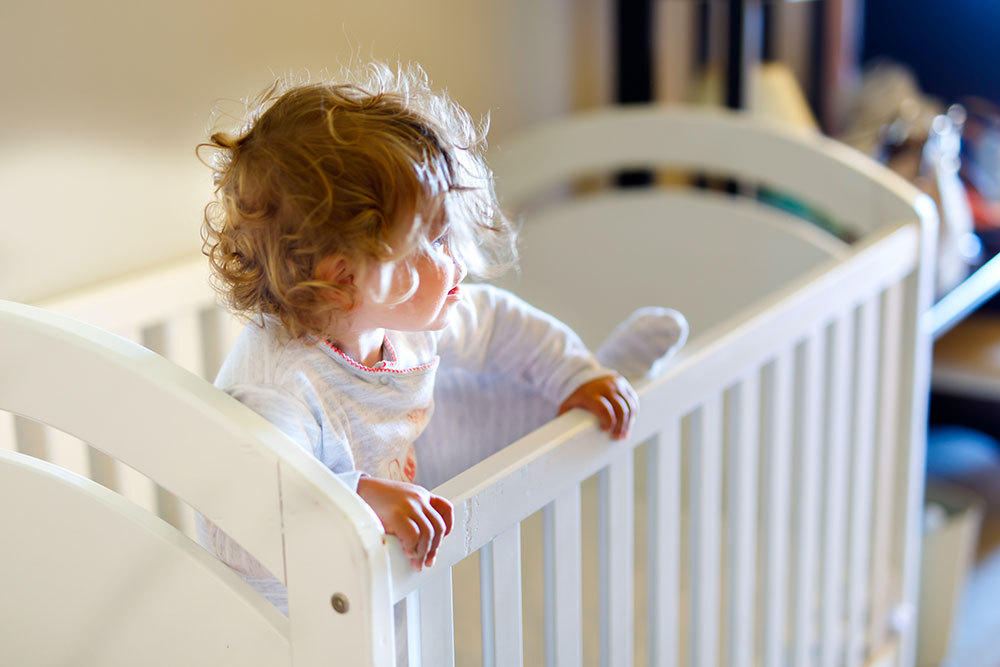Transitioning From Bassinet to Crib to Toddler Bed

Helping your little one switch beds is typically less stressful than you’d expect.
Experts: Jessica Berk; Ari Brown, MD, FAAP
Upon becoming a parent, you get bombarded with guidance from friends and family (and strangers on the internet) on how to do just about anything when it comes to raising your child. Oftentimes, the advice is conflicting because what works for one baby may not work for another—but if there’s one recommendation that tends to remain consistent, it’s that a bedtime routine is the key to a restful night’s sleep. This piece of advice is relatively easy to live by, that is, until you reach a point of transition that completely throws off your baby’s nighttime ritual.
There are a number of changes that can impact a child’s bedtime practice and lead to sleep disruptions, but two big ones are the transition from a bassinet to a crib and then the second transition from a crib to a toddler bed. It’s understandable why these switches would rock a child’s world—imagine coming home from work one day to find the bed you’ve come to love so much was switched out for something entirely different without any warning. You’d probably have a few questions.
Since the quality of a caregiver’s sleep is directly related to how well their baby or toddler sleeps, these transitions can make for a very tired and grouchy household. To help things go as smoothly as possible for your little one (and you), it’s best to follow the guidance of experts on when and how to make these big moves.
What Age Should a Baby Move From a Bassinet To a Crib?
Truth be told, your new baby can sleep in a crib as soon as you bring them home. According to Jessica Berk, a sleep consultant in Tampa, Florida, the benefit of using a bassinet during the newborn phase is more for the parent than the baby. “The main difference between a bassinet and a crib is size,” she explains, and since parents typically have baby sleep in a bassinet in their bedroom, the smaller size means it takes up less space. “While a crib is larger than a bassinet, young babies typically prefer to sleep swaddled, and the swaddle will keep them feeling snuggled and cozy regardless of how large the space is they’re sleeping in.”
However, even though a baby can sleep in a crib right away, most caregivers still opt to put their newbies to sleep in a bassinet nearby to keep an eye on them while they’re sleeping and to make nighttime feedings and diaper changes a little easier. If your baby is sleeping in a bassinet, they will need to transition to a crib at a certain time—though the timing is not determined by age, but rather their development.
“When a baby is able to turn and roll—around 2 ½ to 4 months of age—they should be in a safe sleep space that allows full mobility,” says Ari Brown, MD, FAAP, a pediatrician practicing in Austin, Texas and a spokesperson for the American Academy of Pediatrics (AAP). Dr. Brown further explains, “They do not need to be completely rolling over yet to make the move to the crib,” however, she says, “When a baby does show signs of turning and rolling, they should not be wrapped or swaddled, which interferes with their ability to have full mobility.”
Additionally, Dr. Brown reminds caregivers that to create a safe sleep environment for your baby there should not be any loose bedding or additional objects in the crib with them. “We recommend a ‘naked’ crib for SIDS and SUID prevention,” she says, “just a crib mattress and a fitted mattress sheet.” She also suggests dressing babies in sleeper pajamas or a sleep sack that doesn’t restrict movement in any way. “There are tons of ‘transition swaddle’ products, weighted blankets, etc., and all are no-nos,” she warns. (Read more on the AAP’s guidance on safe swaddling here.)
When Should Babies Sleep In a Crib in Their Own Room?
Whether you opt to place your newborn in a crib right away or you’d rather give it a few months before making that transition, the next question is, where is the best place for the crib to be?
“Great question, and the advice is somewhat confusing,” says Dr. Brown. “The AAP SIDS task force advises that room sharing is recommended for the first six months of life and encouraged for the first year of life for SIDS protection.”
Dr. Brown further explains that 90% of SIDS occurs in babies from birth to six months of age, which is why it’s recommended to room share for at least the first six months. After that point, she says, “Once your baby is sleeping through the night and no longer nursing at night, [you] can decide to move baby into a crib in their own room if [you] choose to do so.”
When it comes to moving your little one into their nursery, Berk defers to the AAP’s timeline guidance on room sharing. She also points out that while room sharing is recommended for the first six months, caregivers should not co-sleep, as this can put baby at risk of suffocation.
When Should You Move a Child From a Crib To a Toddler Bed?
Both Berk and Dr. Brown say that the ideal time to transition your child to a toddler bed is when they are around 3 years old. “Moving kids to a bed earlier can be challenging because they may not be mature enough to handle the freedom of an open toddler bed,” says Berk. “Being able to get out of bed and run around their room (or the house) can be very exciting! Older, more mature kids make the transition more smoothly because they can better understand rules about staying in the bed.”
While age 3 seems to be the magic number for this milestone, there are cases where this transition should happen sooner. If your child has reached the maximum weight or height capacity for their crib or learned how to crawl out of the crib before they reach age 3, then making the switch early is the safest option.
Regardless of exactly when your child moves to a toddler bed, Dr. Brown stresses the importance of childproofing to ensure their entire room is a safe sleep space. “Remove furniture they can climb up on or pull down. Consider how you will keep them safe and not allow access to the entire house or put an alarm on their door—just because they move to a toddler bed does not mean your child is ready to have free access to your home while you are sleeping,” she stresses.
How Long Does It Take To Transition To a Toddler Bed From a Crib?
The good news? For most kids, as long as you’re not making the move too early, this transition is usually relatively quick and easy. “You just make the move and start fresh,” says Dr. Brown. “It make take a few days [for your child] to adjust, but if you make it the new normal, they will too.”
To help make the process even easier, both Berk and Dr. Brown encourage caregivers to help their child establish healthy sleep habits before moving from crib to toddler bed. If a good bedtime routine is already in place, then you can keep going through those normal steps so that the only piece that’s different is your child’s physical bed.
If the switch doesn’t go as smoothly as you’d hoped, that’s OK—it can be fixed! “If sleep becomes a struggle after the transition to a toddler bed, parents need to be honest, intentional, and face the issue head-on,” says Berk. “They should come up with a plan that provides structure for the child’s bedtime routine and learn how to respond to their child’s behaviors in a way that will encourage them to stop stalling and go to bed … Armed with a plan, parents should be able to get their child comfortable sleeping through the night in a toddler bed in less than two weeks.”
Some suggestions Berk has for caregivers of a child struggling with this transition include:
- Have your child practice their own bedtime routine with a doll or lovey; have them tuck the doll into the new bed, say goodnight, and then leave the room.
- Offer your child praise for sleeping well in their new bed after the first new nights.
- Allow your child to brag about their achievements to friends and family.
- If you think a small incentive will be helpful, don’t hesitate to offer a reward like an M&M or a new set of crayons.
Whether you’re transitioning from a bassinet to a crib or from a crib to a toddler bed (or later—to a big kid bed!), remember that this switch is necessary for growth—and it’s a good thing. “As a parent myself, I think we all fear or dread transitions with our children,” says Dr. Brown. “But, we have to grow with our kids and that means change. If we handle it calmly and trust the resiliency of our kids, they will do just fine!”








